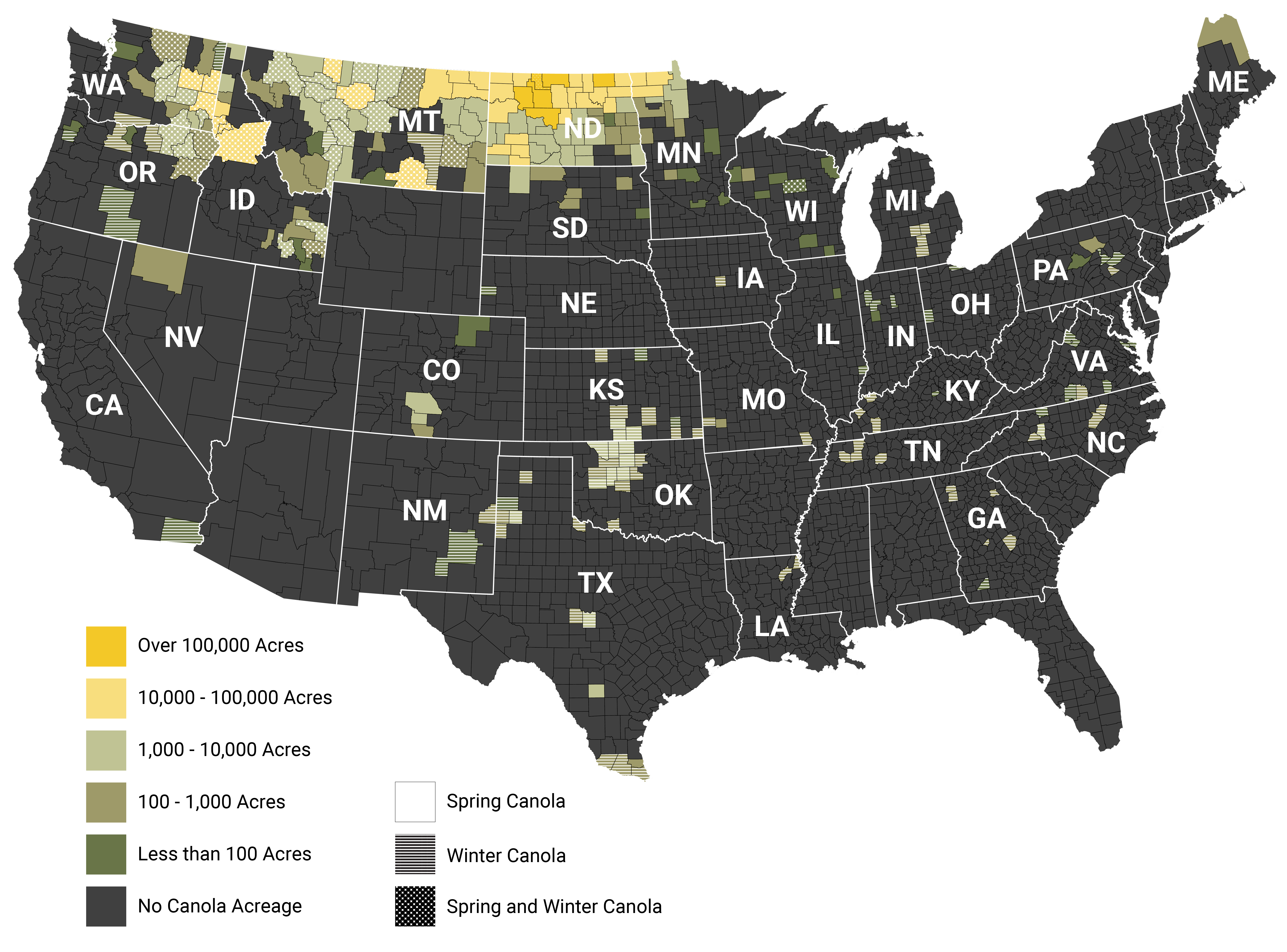 The Congressional Budget Office (CBO) released updated baseline projections in early May for a potential new farm bill, but they pose challenges by increasing costs for the Supplemental Nutrition Assistance Program and farm programs. The CBO’s decreased crop price projections remain largely unchanged, particularly for large commodities. For canola, projections range from $16.70 to $18.50 per cwt, which are below historical and North Dakota State University averages. As a result, the CBO estimates federal price support outlays of $521 million over 10 years for canola. The Farm Bureau has a CBO analysis with graphics that show aggregate and large commodity numbers.
The Congressional Budget Office (CBO) released updated baseline projections in early May for a potential new farm bill, but they pose challenges by increasing costs for the Supplemental Nutrition Assistance Program and farm programs. The CBO’s decreased crop price projections remain largely unchanged, particularly for large commodities. For canola, projections range from $16.70 to $18.50 per cwt, which are below historical and North Dakota State University averages. As a result, the CBO estimates federal price support outlays of $521 million over 10 years for canola. The Farm Bureau has a CBO analysis with graphics that show aggregate and large commodity numbers.
The House Agriculture Appropriations Subcommittee introduced the FY24 agriculture appropriations bill on May 17, which would lead to a 2.1% reduction in U.S. Department of Agriculture (USDA) funding. The bill, which includes more than $25.3 billion in funding, would give $8.15 billion in offset funding from previous spending through COVID relief packages and the Inflation Reduction Act. The bill also proposes an increase of $1.2 million for USDA’s Agricultural Research Service but a $9.5 million cut for the National Institute of Food and Agriculture, with restrictions placed on Secretary of Agriculture Tom Vilsack’s use of the Commodity Credit Corporation.
 President Joe Biden and leaders of the House and Senate agricultural committees met on May 11 to discuss passing a bipartisan farm bill this year. In a joint statement, the committees said: “The farm bill is a jobs bill. It is a safety net for farmers and consumers, and it is an investment in our rural communities and the health of the American people.”
President Joe Biden and leaders of the House and Senate agricultural committees met on May 11 to discuss passing a bipartisan farm bill this year. In a joint statement, the committees said: “The farm bill is a jobs bill. It is a safety net for farmers and consumers, and it is an investment in our rural communities and the health of the American people.”
Several conservative and progressive groups sent a joint letter to Congressional agriculture committee leaders expressing their opposition to any increases in reference prices in the next farm bill. The groups argued that with net farm income currently at record levels, increasing farm subsidies is unnecessary. They also countered claims that reference prices have not kept up with inflation, stating that gross farm income has consistently outpaced the cost of farm production.
 On May 25, the Supreme Court issued a ruling that significantly reduced the scope of the Clean Water Act as interpreted by the federal government. The ruling states that the law only regulates wetlands when they are “as a practical matter indistinguishable from waters of the United States.” This means that the U.S. Environmental Protection Agency (EPA) and Army Corps of Engineers will have to re-examine their rule that went into effect in March, in which they “maintain that the significant-nexus test has been and remains sufficient to establish jurisdiction over ‘adjacent’ wetlands,” said Justice Samuel Alito, writing for the majority.
On May 25, the Supreme Court issued a ruling that significantly reduced the scope of the Clean Water Act as interpreted by the federal government. The ruling states that the law only regulates wetlands when they are “as a practical matter indistinguishable from waters of the United States.” This means that the U.S. Environmental Protection Agency (EPA) and Army Corps of Engineers will have to re-examine their rule that went into effect in March, in which they “maintain that the significant-nexus test has been and remains sufficient to establish jurisdiction over ‘adjacent’ wetlands,” said Justice Samuel Alito, writing for the majority.
 The EPA conducted new analyses to identify federally endangered or threatened species that face the greatest risks from neonicotinoid insecticides, including clothianidin, imidacloprid and thiamethoxam. These analyses, which are not typically part of EPA’s assessments under the Endangered Species Act, were conducted to expedite consultations with the U.S. Fish and Wildlife Service and National Marine Fisheries Service. The analyses will help prioritize mitigation measures for the most at-risk species, accounting for 9-11% of threatened or endangered species. The EPA has finalized the biological evaluations for these insecticides and will provide them to the Fish and Wildlife Service for final determinations.
The EPA conducted new analyses to identify federally endangered or threatened species that face the greatest risks from neonicotinoid insecticides, including clothianidin, imidacloprid and thiamethoxam. These analyses, which are not typically part of EPA’s assessments under the Endangered Species Act, were conducted to expedite consultations with the U.S. Fish and Wildlife Service and National Marine Fisheries Service. The analyses will help prioritize mitigation measures for the most at-risk species, accounting for 9-11% of threatened or endangered species. The EPA has finalized the biological evaluations for these insecticides and will provide them to the Fish and Wildlife Service for final determinations.
The EPA issued a final rule on May 25 to exempt a class of genetically engineered plant-incorporated protectants (PIPs) from registration requirements under the Federal Insecticide, Fungicide, and Rodenticide Act and food/feed residue tolerance requirements under the Federal Food, Drug, and Cosmetic Act. However, the American Seed Trade Association (ASTA) expressed disappointment with the rule, stating that it adds bureaucratic red tape for the development of improved plant varieties using innovative breeding techniques, despite the EPA’s recognition of their safety. ASTA believes this rule hampers the competitiveness of the U.S. seed industry and contradicts efforts to streamline regulations within the U.S. Coordinated Framework.
The EPA has submitted its final biofuel blending rule to the White House for review, which will determine the amounts that oil refiners must blend into their fuels over the next three years under the Renewable Fuel Standard. Right now, it’s unclear if the final rule will change from the proposed rule in December, which proposed 20.82 billion gallons of biofuels in 2023, 21.87 billion gallons in 2024, and 22.68 billion gallons in 2025.
 The U.S. Canola Association (USCA) expressed support for a package of bills considered by the House Transportation & Infrastructure Committee, including measures to promote trucking safety and streamline commercial driver license requirements. The USCA also signed a coalition letter endorsing the America Grows Act of 2023 introduced by Senators Dick Durbin (D-IL) and Jerry Moran (R-KS), which aims to increase funding for agricultural research over the next decade in various USDA agencies. Additionally, the USCA signed a letter urging Congress to reaffirm federal law that prevents states and localities from imposing health risk claims on pesticide labels that contradict federal findings as this could create a disruptive and contradictory regulatory landscape.
The U.S. Canola Association (USCA) expressed support for a package of bills considered by the House Transportation & Infrastructure Committee, including measures to promote trucking safety and streamline commercial driver license requirements. The USCA also signed a coalition letter endorsing the America Grows Act of 2023 introduced by Senators Dick Durbin (D-IL) and Jerry Moran (R-KS), which aims to increase funding for agricultural research over the next decade in various USDA agencies. Additionally, the USCA signed a letter urging Congress to reaffirm federal law that prevents states and localities from imposing health risk claims on pesticide labels that contradict federal findings as this could create a disruptive and contradictory regulatory landscape.
The USDA Risk Management Agency’s Federal Crop Insurance Corporation will hold listening sessions and invite comments on prevent plant issues and rules. It is seeking input on the harvest price option and “1 in 4” requirement. A virtual listening session will be June 8 and one in-person will be in August in West Fargo, N.D. If you have input for the USCA to consider submitting, please send it to Tom Hance at thance@gordley.com.
 How can you get rid of root rot? On RealAgriculture.com, Clint Jurke at the Canola Council of Canada and Alison Robertson at Iowa State University stress in a video the importance of early detection and proper management strategies to mitigate the effects of root rot. This can include monitoring dampness, temperature, seed quantity among other things.
How can you get rid of root rot? On RealAgriculture.com, Clint Jurke at the Canola Council of Canada and Alison Robertson at Iowa State University stress in a video the importance of early detection and proper management strategies to mitigate the effects of root rot. This can include monitoring dampness, temperature, seed quantity among other things.
The threat of Verticillium Stripe is real and canola farmers should take steps to prevent this soil-borne fungal disease from affecting crops. It can limit the nutrients and water a plant receives and cause plants to flop over, making harvesting difficult. David Kaminski, a field crop pathologist with Manitoba Agriculture, advises stretching the interval between crops of the same type and avoiding tight canola rotations.
 Did you know that canola oil is heart-healthy? It has the least saturated fat of all common cooking oils, which is why the American Heart Association includes canola oil in its Heart-Check Food Certification Program. This approval resulted from canola oil receiving a qualified health claim from the U.S. Food and Drug Administration on its ability to reduce the risk of heart disease when consumed in place of saturated fat.
Did you know that canola oil is heart-healthy? It has the least saturated fat of all common cooking oils, which is why the American Heart Association includes canola oil in its Heart-Check Food Certification Program. This approval resulted from canola oil receiving a qualified health claim from the U.S. Food and Drug Administration on its ability to reduce the risk of heart disease when consumed in place of saturated fat.
The International Food Information Council released its 18th annual food and health survey, which reveals dietary trends. Results indicate that in spite of increased food costs, Americans are willing to pay top dollar for socially sustainable options and roughly half surveyed have followed an eating pattern or diet in the past year.
 The Canadian government is once again concerned that China will block canola shipments from Canada. Recently, the Canadian government expelled Chinese diplomat Zhao Wei because he was potentially involved in a plot to intimidate Conservative Member of Parliament Michael Chong and his relatives in Hong Kong. This is following a disagreement in 2019 when China blocked canola shipments from two major Canadian companies in 2019 for three years following the arrest of Huawei executive Meng Wanzhou. To date, nothing has been announced.
The Canadian government is once again concerned that China will block canola shipments from Canada. Recently, the Canadian government expelled Chinese diplomat Zhao Wei because he was potentially involved in a plot to intimidate Conservative Member of Parliament Michael Chong and his relatives in Hong Kong. This is following a disagreement in 2019 when China blocked canola shipments from two major Canadian companies in 2019 for three years following the arrest of Huawei executive Meng Wanzhou. To date, nothing has been announced.
The European Union announced it intends to reduce the maximum residue limit (MRL) for haloxyfop herbicide from 0.2mg/kg to 0.005mg/kg. Haloxyfop is one of the most affordable means of controlling grass weeds in canola. But any canola exports from Canada to the EU in the 2023-24 season that go beyond the MRL limit on will not be able to be delivered.

A Canadian grower in Essex County is welcoming people to take photos near or in his 100-acre canola field in exchange for donations to a local food bank. Karl Neudorf said it was his wife’s idea and the response has been overwhelming. To date, they have collected over a thousand dollars.
Image by Chris Campbell/CTV News Windsor
 The Oregon State Legislature is considering enacting a permanent 500-acre limit on canola in Willamette Valley. In addition to the limit, Senate Bill 789 would continue to require canola growers to be licensed by the Oregon Department of Agriculture. Violators could be fined as much as $25,000 and issued a plow out order for the crop. The bill was proposed by the Oregon Organics Coalition due to concerns of genetically modified canola outcrossing with other Brassica crops in the area, which is known for specialty seed production. But an Oregon State University study concluded that cross-pollination as well as pest disease and weed pressures can be avoided if canola fields maintain isolation distances with sexually compatible crops. The bill passed the Senate and a public hearing occurred last month in the House Committee on Agriculture, Land Use, Natural Resources and Water. The bill was sent to the House Rules Committee without recommendation for further review. The Oregon Legislature is constitutionally bound to adjourn this biennium (two fiscal year period) by June 25.
The Oregon State Legislature is considering enacting a permanent 500-acre limit on canola in Willamette Valley. In addition to the limit, Senate Bill 789 would continue to require canola growers to be licensed by the Oregon Department of Agriculture. Violators could be fined as much as $25,000 and issued a plow out order for the crop. The bill was proposed by the Oregon Organics Coalition due to concerns of genetically modified canola outcrossing with other Brassica crops in the area, which is known for specialty seed production. But an Oregon State University study concluded that cross-pollination as well as pest disease and weed pressures can be avoided if canola fields maintain isolation distances with sexually compatible crops. The bill passed the Senate and a public hearing occurred last month in the House Committee on Agriculture, Land Use, Natural Resources and Water. The bill was sent to the House Rules Committee without recommendation for further review. The Oregon Legislature is constitutionally bound to adjourn this biennium (two fiscal year period) by June 25.
Glencore PLC, a trader of global commodities, is in talks to merge its agricultural division, which includes Viterra Ltd. that it acquired in 2012, with Bunge Ltd. Viterra operates a network of grain elevators, special crops facilities, processing plants and port terminals across Canada and parts of the United States. Glencore initially proposed a merger with St. Louis-based Bunge in 2017, which was then rejected. This time a deal looks likely, according to The Globe and Mail (Canada).
NutraIngredients.com reported on Nutriterra omega-3-enhanced canola oil by Nuseed as a sustainable source of DHA, EPA and DPA long-chain omega-3 fatty acids normally found in algae and fish. Research shows that a majority of Americans are deficient in these omega-3s, which help prevent heart disease and stroke. According Doug Bibus, PhD, CEO of Lipid Technologies LLC, 3.5 acres of Nuseed canola produces as much DHA as 10,000 one-kilogram fish.
 The U.S. Department of Agriculture has granted $3 million to Tidewater Transportation and Terminals Inc. in Pasco, Wash., to increase biodiesel production and distribution to help Washington, Oregon and Idaho farmers meet clean energy needs during peak harvest seasons. When the project is completed next year, Tidewater will be able to blend more than 2 million gallons of biodiesel per month and offload it for local deliveries to gas stations, diesel freight trucks and construction equipment.
The U.S. Department of Agriculture has granted $3 million to Tidewater Transportation and Terminals Inc. in Pasco, Wash., to increase biodiesel production and distribution to help Washington, Oregon and Idaho farmers meet clean energy needs during peak harvest seasons. When the project is completed next year, Tidewater will be able to blend more than 2 million gallons of biodiesel per month and offload it for local deliveries to gas stations, diesel freight trucks and construction equipment.
The USCA will host its fall board meeting in St. Louis, Mo., Oct. 29-31 in conjunction with the National Canola Research Conference and 2023 ASA, CSSA, SSSA International Annual Meeting. Register by Sept. 20 at https://www.acsmeetings.org/register.
 Want to see exactly where canola is growing in the United States? The USCA just uploaded a new canola acreage map by county on its website.
Want to see exactly where canola is growing in the United States? The USCA just uploaded a new canola acreage map by county on its website.
Get social with us on Instagram, LinkedIn, Facebook, Twitter and YouTube.
Want to promote your products or services to canola producers and industry members? Visit our advertising pages to find specs, deadlines and rates to advertise in this monthly e-newsletter or on UScanola.com.
 The Congressional Budget Office (CBO) released updated baseline projections in early May for a potential new farm bill, but they pose challenges by increasing costs for the Supplemental Nutrition Assistance Program and farm programs. The CBO’s decreased crop price projections remain largely unchanged, particularly for large commodities. For canola, projections range from $16.70 to $18.50 per cwt, which are below historical and North Dakota State University averages. As a result, the CBO estimates federal price support outlays of $521 million over 10 years for canola. The Farm Bureau has a CBO analysis with graphics that show aggregate and large commodity numbers.
The Congressional Budget Office (CBO) released updated baseline projections in early May for a potential new farm bill, but they pose challenges by increasing costs for the Supplemental Nutrition Assistance Program and farm programs. The CBO’s decreased crop price projections remain largely unchanged, particularly for large commodities. For canola, projections range from $16.70 to $18.50 per cwt, which are below historical and North Dakota State University averages. As a result, the CBO estimates federal price support outlays of $521 million over 10 years for canola. The Farm Bureau has a CBO analysis with graphics that show aggregate and large commodity numbers. President Joe Biden and leaders of the House and Senate agricultural committees met on May 11 to discuss passing a bipartisan farm bill this year. In a joint statement, the committees said: “The farm bill is a jobs bill. It is a safety net for farmers and consumers, and it is an investment in our rural communities and the health of the American people.”
President Joe Biden and leaders of the House and Senate agricultural committees met on May 11 to discuss passing a bipartisan farm bill this year. In a joint statement, the committees said: “The farm bill is a jobs bill. It is a safety net for farmers and consumers, and it is an investment in our rural communities and the health of the American people.”  On May 25, the Supreme Court issued a ruling that significantly reduced the scope of the Clean Water Act as interpreted by the federal government. The ruling states that the law only regulates wetlands when they are “as a practical matter indistinguishable from waters of the United States.” This means that the U.S. Environmental Protection Agency (EPA) and Army Corps of Engineers will have to re-examine their rule that went into effect in March, in which they “maintain that the significant-nexus test has been and remains sufficient to establish jurisdiction over ‘adjacent’ wetlands,” said Justice Samuel Alito, writing for the majority.
On May 25, the Supreme Court issued a ruling that significantly reduced the scope of the Clean Water Act as interpreted by the federal government. The ruling states that the law only regulates wetlands when they are “as a practical matter indistinguishable from waters of the United States.” This means that the U.S. Environmental Protection Agency (EPA) and Army Corps of Engineers will have to re-examine their rule that went into effect in March, in which they “maintain that the significant-nexus test has been and remains sufficient to establish jurisdiction over ‘adjacent’ wetlands,” said Justice Samuel Alito, writing for the majority. The EPA conducted new analyses to identify federally endangered or threatened species that face the greatest risks from neonicotinoid insecticides, including clothianidin, imidacloprid and thiamethoxam. These analyses, which are not typically part of EPA’s assessments under the Endangered Species Act, were conducted to expedite consultations with the U.S. Fish and Wildlife Service and National Marine Fisheries Service. The analyses will help prioritize mitigation measures for the most at-risk species, accounting for 9-11% of threatened or endangered species. The EPA has finalized the biological evaluations for these insecticides and will provide them to the Fish and Wildlife Service for final determinations.
The EPA conducted new analyses to identify federally endangered or threatened species that face the greatest risks from neonicotinoid insecticides, including clothianidin, imidacloprid and thiamethoxam. These analyses, which are not typically part of EPA’s assessments under the Endangered Species Act, were conducted to expedite consultations with the U.S. Fish and Wildlife Service and National Marine Fisheries Service. The analyses will help prioritize mitigation measures for the most at-risk species, accounting for 9-11% of threatened or endangered species. The EPA has finalized the biological evaluations for these insecticides and will provide them to the Fish and Wildlife Service for final determinations. The U.S. Canola Association (USCA) expressed support for a package of bills considered by the House Transportation & Infrastructure Committee, including measures to promote trucking safety and streamline commercial driver license requirements. The USCA also signed a coalition letter endorsing the America Grows Act of 2023 introduced by Senators Dick Durbin (D-IL) and Jerry Moran (R-KS), which aims to increase funding for agricultural research over the next decade in various USDA agencies. Additionally, the USCA signed a letter urging Congress to reaffirm federal law that prevents states and localities from imposing health risk claims on pesticide labels that contradict federal findings as this could create a disruptive and contradictory regulatory landscape.
The U.S. Canola Association (USCA) expressed support for a package of bills considered by the House Transportation & Infrastructure Committee, including measures to promote trucking safety and streamline commercial driver license requirements. The USCA also signed a coalition letter endorsing the America Grows Act of 2023 introduced by Senators Dick Durbin (D-IL) and Jerry Moran (R-KS), which aims to increase funding for agricultural research over the next decade in various USDA agencies. Additionally, the USCA signed a letter urging Congress to reaffirm federal law that prevents states and localities from imposing health risk claims on pesticide labels that contradict federal findings as this could create a disruptive and contradictory regulatory landscape.

 How can you get rid of root rot? On
How can you get rid of root rot? On  Did you know that canola oil is heart-healthy? It has the least saturated fat of all common cooking oils, which is why the
Did you know that canola oil is heart-healthy? It has the least saturated fat of all common cooking oils, which is why the  The
The 
 The
The  The
The  Want to see exactly where canola is growing in the United States? The USCA just uploaded a new canola acreage map by county on its
Want to see exactly where canola is growing in the United States? The USCA just uploaded a new canola acreage map by county on its